


Art Posters in Lebanon from the Jafet Library at the American University of Beirut.
[inadvertently via Agence E]
Saturday, January 07, 2006
Art Posters in Lebanon
The History of Geology in Rare Books

 The above images come from the amazing Jesuit polymath,
The above images come from the amazing Jesuit polymath,Athanasius Kircher. He was moved to produce a sort of
pre-geological treatise, Mundus Subterraneus (1665), after having witnessed
the eruption of Mount Etna (2nd image) and visiting the dynamic
summits of both Etna and Vesuvius. The top image shows Kircher's
understanding of the origin of volcano eruptions.
 Priest and naturalist Lazzaro Spallanzani spent time in the
Priest and naturalist Lazzaro Spallanzani spent time in theAeolian islands off Italy where he descended into the craters
of both Vulcano and Stromboli to collect specimens. His later laboratory
testing introduced an experimental dimension to vulcanological
studies. The engraving Stromboli comes from his multi-volume
Travels series, published 1792-1799.
 Although unattributed, an engraving of Susanna Drury's
Although unattributed, an engraving of Susanna Drury'sgouache drawing of the Giant's Causeway in Northern
Ireland from 1740 was included in Volume 12 of Diderot's
famous Encyclopédie, published in 1765.
 A view of a castle in Stolpen, Germany, built on
A view of a castle in Stolpen, Germany, built oncolumnar basalt in Institutiones géologiques by
noted geologist, Scipione Breislak in 1818.
 Sir Joseph Banks made Staffa (Fingal's cave) island in the Scottish Hebrides
Sir Joseph Banks made Staffa (Fingal's cave) island in the Scottish Hebridesknown to the outside world and used some engravings
made by Thomas Pennant when he published
Tour in Scotland, and Voyage to the Hebrides in 1772.
Pennant also wrote the section of text about the island's
hexagonally-jointed basalt formations.
Vulcan’s Forge and Fingal’s Cave - Volcanoes, Basalt, and the Discovery of Geological Time is a 70 webpage exhibition at the Linda Hall Library of Science Engineering and Technology which displays illustrations from rare texts published between 1565 and 1835.
Friday, January 06, 2006
Himmapan Mythical Creatures
"If you have ever visited Asian countries such as Thailand or India, you may find some similarities in their art and architecture. If you look closely into these arts and crafts, you will see many strange animals decorating the scenes. Most of them are what can be described as a "combined-animal" as for example, a horse with a bird's head, a man with lion body, etc. These animals are actually mythical creatures who dwell in the legendary Himmapan Forest. The forest is said to be located in the Himalaya Mountains."
Images © Himmapan.com [via Jaf Project](Thanks for the reminder D)
Carácas in 1877
Mystic Seaport



 Mystic Seaport is in Connecticut and proclaims itself to be the 'Museum of America and the Sea'.
Mystic Seaport is in Connecticut and proclaims itself to be the 'Museum of America and the Sea'.
It was founded in 1929 and has a substantial online presence. Although I wouldn't describe the site(s) as counter-intuitive, it took a fair amount of sifting and retracing of steps to get an appreciation for just what's available. I'm sure I'll return here in the future - but it will be with some hesitation (maybe it's just me or today or something). The website is partly funded by and connected to the Library of Congress.
This is the link to a full list of Mystic Seaport's digital holdings by subject. The compilations online are partly itemization lists of collections and partly digital examples. But there is everything from fully uploaded books to crew journals to passenger lists to maps and charts, to correspondence to scrapbooks to inventories and bills of sales, to ship plans and much more besides. There is a host of material available for any maritime aficionados, that's for sure.
(I'm getting server errors trying to load any of the prints at present)
The images above are from the sailing card collection .....
"Agents or owners commonly advertised the availability and loading of their vessels in the local newspapers, but by the mid-1850's the colorful sailing cards began to appear in the windows of shipping firms, banks, and public shops along the waterfronts in ports like New York and Boston."
Thursday, January 05, 2006
Curious Cartography
"If these geographical puzzles excite the mirth of children, the amusement of the moment may lead to the profitable curiosity of youthful students and embue the mind with a healthful taste for foreign lands."
 A hook-nosed lady represents fair France,
A hook-nosed lady represents fair France,Empress of cooks, of fashions, and the dance.
Her flatt'ring glass declares that vict'ry pwer,
Beauty, wealth, arts, are her imperial dower.
 For Shakespeare's Prince, and the Princess of wales,
For Shakespeare's Prince, and the Princess of wales,To England dear. Her royal spirit quails;
From skating faint, she rests upon the snow;
Shrinking from unclean beasts that grin below.
 A gallant piper, stuggling through the bogs,
A gallant piper, stuggling through the bogs,His wind bag broken, wearing his clay clogs;
Yet, strong of heart, a fitting emblem makes
For Scotland - land of heroes and of cakes.
 Peter, and Catherine, and Alexander,
Peter, and Catherine, and Alexander,Mad Paul, and Nicholas, poor shadows wander
Out in the cold; while Emperor A. the Second
In Eagles, Priests, and Bears supreme is reckoned.
Aleph tells us that a 14 year old girl produced these caricatured maps by way of entertainment for her brother who was ill in bed. The series of 12 colour lithographs were released by the journalist/author William Harvey in 1869 using a pseudonym and the quote above is from the introduction. Each of the 12 European countries depicted in one form or other of stereotype includes a small descriptive verse.
Wednesday, January 04, 2006
National Diet Library Sketch Scraps









 The good news is that while playing 'blind copy and paste the Japanese ideogram' at the search page in the rare books collection of the Japanese National Diet Library, I managed to find 3 sketch/scrapbooks from which I snagged these images.
The good news is that while playing 'blind copy and paste the Japanese ideogram' at the search page in the rare books collection of the Japanese National Diet Library, I managed to find 3 sketch/scrapbooks from which I snagged these images.
The bad news is that my computer crashed before I'd finished making this post and despite going through the browser history, the site has session timeouts and there's no way on earth I can remember which ideogram I used. Damn shame - it was a nice collection of eclectic pastings and ink scribbles and paintings, with a lot of simple but elegant designs. I hope the selection here gives a reasonable indication of the qualities. One of the images above is dated 1826.
(some of these images have had their backgrounds cleaned up a bit)
Redefining the Book
 Little Red Riding Hood
Little Red Riding HoodJan Hogan 1992
Lithographs on paper mounted on sixteen wooden blocks,
held in wooden box with two-part hinged lid;
each block has one letter and three printed illustrations.
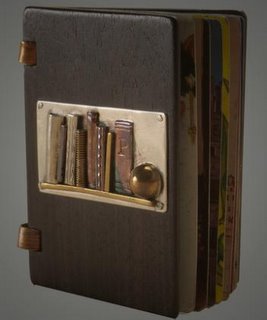 Artist Book
Artist BookPierre Cavalan 1998
Pages made from metal biscuit, olive oil, etc. containers;
wooden covers bound with two copper rings; metal plaque
of copper brass and stainless steel attached to front cover
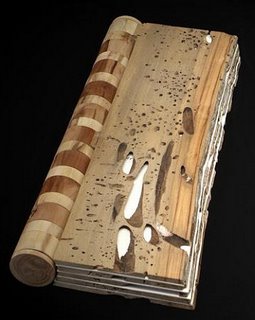 The Grub in the Wood of Time
The Grub in the Wood of Time1989
'Four copies of this book were hand-written by the author.
Sun Evrard conceived the idea, John Tonkin designed the construction,
and the colour plates were made by Sun Evrard and John Tonkin.
Frank Wiesner supplied the wooden pages; & Serge Amburger
manufactured the hinges & assembled the wooden pages to them'
 Tennis Ball
Tennis BallLinda Newbown 2001
Yellow tennis ball, cut in half, hinged and pages with text inserted.
"Tennis Ball is the concrete form of my thinking about
the intersection of book as an abstract idea,
as an object and as the carrier of information."
Artists' Books Online - Redefining the Book - at the Queensland State Library.
Zoological Miscellany
Tuesday, January 03, 2006
De Re Militari
"The ancients preferred discipline to numbers."
"Few men are born brave; many become so
through training and force of discipline."
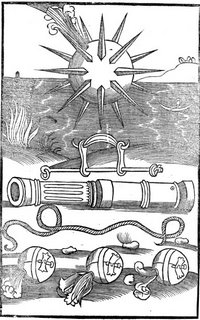
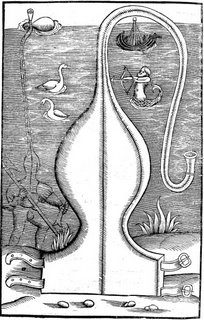


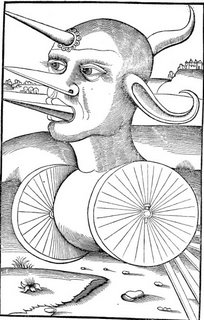 When the Roman empire was in decline at the end of the 4th century, Flavius Vegetius Renatus (Végèce in french I think) wrote De Re Militari which became the veritable bible with regards the art of war for more than a thousand years. The maxims he recorded may still be heard today but they did little to boost the plight of the Roman armies.
When the Roman empire was in decline at the end of the 4th century, Flavius Vegetius Renatus (Végèce in french I think) wrote De Re Militari which became the veritable bible with regards the art of war for more than a thousand years. The maxims he recorded may still be heard today but they did little to boost the plight of the Roman armies.It remains the foremost authority on Roman military systems.
The images here come from an early french publication (in latin). The book was written in 1498 and published by C. Wecheli in Paris in 1535. I have a very strong feeling both that this text includes elements from other works (Elien the Tactician, Frontin's Strategies) and that the many woodcuts incorporate middle ages technologies. I may be wrong - not only am I no expert but I also got quite confused traversing french and english spellings and translations fossicking for background. Nothing written here should ever be regarded as having authority and that is particularly so for this entry (all care taken ... buyer beware etc).



































